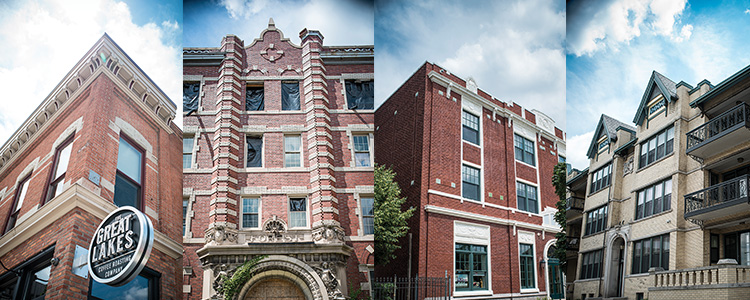
Some important things fell into place three years ago in Midtown. National investors started grabbing real estate, land, and attention. People steadily moved there, creating a housing shortage. Entrepreneurs set up shop to sell cappuccinos and clothes. Long anchored by some of Detroitтs best cultural assets, Midtown, it seemed, had finally upgraded to an urban DVR of sorts, giving interested parties a way to skip to the best parts of the show.
The Midtown тshow,т of course, is some three decades in the making, with Sue Mosey, president of the nonprofit community-development organization Midtown Detroit Inc., acting as its director. But unlike those quick to gush over Midtownтs latest momentum, Mosey has witnessed plenty of false starts, and she never had a fast-forward button. Insiders will tell you now that Moseyтs maniacal mission is largely whatтs bringing this Detroit neighborhood back block by block т and that few can comprehend the gumption it takes.
тLetтs face it, a lot of Midtownтs buildings didnтt have people standing in long lines waiting to put bids on them,т says Christina Lovio-George, a longtime Detroit PR professional who worked with Mosey to brand the home turf of the Detroit Institute of Arts and Wayne State University as тMidtownт in the 1990s. тWhat (Mosey) did for the first 20 years with no money is a testament to what face time and hard work can do.т
This is typical of the praise Mosey gets, but sheтs uncomfortable casting herself as a savior of anything. A native Detroiter who graduated from Wayne State with an urban planning degree, sheтs also surprised by the curiosity during the last couple of years by both local and national journalists who continually call her for interviews. Lately, she admits, talking to the media has become like a second full-time job.
тYesterday I spent all day with the The Detroit News. Today Iтm talking to (ЯуИлСљКЯВЪЭМПтзЪСЯ). Tomorrow Iтm with the Financial Times,т Mosey says. тI mean, this is like every week.т
Who could blame them? In a city defined by its governmental debacles and now a historic bankruptcy filing, people understandably want to figure out how Midtown seems to be making it. Specifically, they want to know how Mosey is making it, essentially without the help of a functioning city government. Sheтs always gracious in her willingness to tell the story, because she knows whatтs on the line. Outsiders, she says, need to have as much faith as she does in her little pocket of Detroit. She always points out that sheтs had a lot of help from other community-minded visionaries. As for her unique vision years ago that poised the area to become more than a place for art festivals т earning her the unofficial nickname тMayor of Midtownт т well, letтs just say ceremonial titles arenтt Moseyтs thing.
 тPeople tell me every day that they canтt find any place to live, so we are really, really trying to get housing built,т Mosey says of her most pressing priority.
тPeople tell me every day that they canтt find any place to live, so we are really, really trying to get housing built,т Mosey says of her most pressing priority.
Sitting in Midtown Detroit Inc.тs bright, modern office space on Woodward Avenue where a staff of about 20 work on various initiatives, Mosey is all business and doesnтt stop to give herself pats on the back. She effortlessly ticks off a list of MDIтs current housing-development projects. You get the feeling these projects are etched on her brain and, if blindfolded, she could lead you to all of them.
тThe funny thing for me,т she says, тis I donтt really see any change. Maybe itтs because Iтve been here for so long. The only thing that keeps me going is when people whoтve been away come back and tell me how great (Midtown) looks. Because I swear when I drive around, all I do is shake my head.т
тWhere Life Is Artт
Despite Moseyтs natural tendency to hedge her bets, she canтt deny that Midtown has earned a national reputation as a very different part of Detroit where entrepreneurial spirit is high and crime is relatively low. People almost universally attribute this to the work of Mosey and MDI, which is known today as a one-stop shop for the local urban lifestyle, equipping the single resident, small business, huge developer, and anyone in between with resources to be successful in an otherwise difficult city. Mosey is passionate about relationships first, personally taking on the burden of knowing every detail of Midtown, from rental occupancy rates to the viability of business plans, so others can make wise decisions.
тIf we want investment,т she says, тwe have to be able to build confidence in the neighborhood.т
Such confidence in Midtown was never a foregone conclusion, as Mosey and other longtime insiders well know. When Mosey started working as a community advocate here in the early 1980s, it was really just a тcollectionт of neighborhoods close in proximity, but with no common identity. There was the Cass Corridor, the area around the Detroit Medical Center, and the cultural center with Wayne State and the DIA.
тAmazingly enough, the community had some awfully good underpinnings,т says Lovio-George, noting that these assets are still sometimes used as the simple explanation for why Midtown never went the way of so many other Detroit neighborhoods.
But that explanation ignores the fact that before Moseyтs strategic vision for the area, most people would go to the DIA, the main Detroit Library, or the Detroit Medical Center and then go home at night. No one lived or did any other serious business in Midtown, save for pioneers like Lovio-George, who made the radical decision in 1982 to move her PR firm to an early 20th-century historic home on West Forest.
Lovio-George at the time was a rising star in Detroitтs PR world, and her client list over the years would include Cobo Center, the Parade Company, Super Bowl XL, and Midtown itself. Still, clients didnтt want to come to her office, and she remembers making lots of trips to the suburbs for business meetings. тPeople thought the brains flew out of my head,т Lovio-George recalls of the reactions she got from wanting to run her business from Midtown.
To counteract these negative perceptions, there was already a small movement in the form of MDIтs predecessor, the University Cultural Center Association (UCCA), to create better awareness and appreciation for the cultural assets of Midtown. Mosey was UCCAтs president, and in its earliest years, the organization concentrated on special events like putting on art festivals and simply elevating the major cultural institutions that were already there.
It was the organizationтs first significant development project in the late 1990s т preserving some notable historic homes to form the Inn on Ferry Street т that signaled the new, business-oriented direction. Trish Hubbell, the wife of late pioneering Midtown developer Colin Hubbell, who built the Canfield Lofts, says that it was Mosey alone who recognized this opportunity to market Midtown in a different way.
тMidtown started as mostly an arts district, but Mosey moved it toward more of an economic plan,т Hubbell says. тShe was really the only one who saw how to use arts and culture to unleash all the economic potential that would make people want to live and work here instead of just visit.т
Strategic building renovations and housing developments, along with residential programs and business incentives to attract entrepreneurs, followed. And although the economic meltdown of 2008 was a significant blow in terms of attracting homebuyers for some of the early initiatives, 2013 started with a bona fide housing shortage. It seemed like MDIтs tagline, тWhere Life Is Art,т was finally starting to take hold, and the possibility that Midtown could be a viable lifestyle option had become real.

Sheтs built it, but will they keep coming?
Under Moseyтs guidance, Midtownтs trajectory has been one worth watching. тIt started really accelerating five years ago, it reached a real crescendo three years ago, and now,т she says, тitтs on steroids.т
The arrival of Whole ЯуИлСљКЯВЪЭМПтзЪСЯs last spring and the promise of M-1 Rail, expected to link Midtown to downtown in the near future, are perhaps the most obvious examples of Midtownтs momentum. It hasnтt been by accident, says Rachel Lutz, owner of Midtown clothing boutique The Peacock Room, though many people unfamiliar with Midtownтs history might see it that way.
тFerry Street couldтve become a parking lot,т she says. тIt was slated for demolition. The reason deals like Ferry Street and everything else [happen] in Midtown is a direct result of Moseyтs vision and perseverance.т
Some of the biggest projects, Mosey says, are yet to come т the result of decades of seed work finally coming to fruition.
Developers are planning to break ground in the fall on a 28,000-square-foot building at Woodward and Willis. Lawrence Technological University will be the anchor tenant, occupying a new design center on the second floor. The old Agave building across from the Whitney is expected to host a new restaurant and four units of housing. And, under the plan, the Forest Arms at Forest and Second will be converted into 75 apartments, with commercial spaces on the ground floor.
MDI is also planning to expand its already successful Green Alley project, in which local bicycle manufacturer Shinola will support the conversions of four new alleys in Midtown that will serve as green spaces for pedestrians and cyclists.
But Mosey doesnтt sugarcoat this trajectory. She says the market in Midtown is still immature, and that anyone whoтs expecting to тhelicopter inт and ride on someone elseтs coattails will be disappointed.
тThis isnтt easy work or quick money,т Mosey says of moving in to Midtown or any other part of Detroit, for that matter. тWe want people who are in it for the long term. Thatтs what weтre looking for. Thatтs the end game.т
|
| Ь§ |
|








